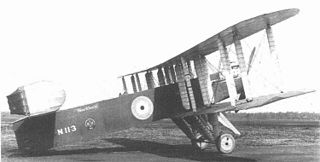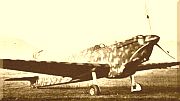Operators
 United Kingdom
United Kingdom
| B.1 | |
|---|---|
| Role | Bomber |
| Manufacturer | Sopwith Aviation Company |
| First flight | 1917 |
| Introduction | 1917 |
| Primary user | Royal Naval Air Service |
| Number built | 2 |
The Sopwith B.1 was an experimental British bomber aircraft of the First World War. A single-seat, single-engined biplane, the B.1 was built by the Sopwith Aviation Company for the Royal Navy. Although only two were built, one was used for bombing raids over France.
In late 1916, Sopwith, whose earlier 1½ Strutter had proved successful as a light bomber (particularly when operated as a single seater), designed a new, single-engined bomber aircraft. The new bomber was developed in parallel with the Cuckoo carrier-based torpedo bomber and closely resembled the Cuckoo. It, like the Cuckoo, was a compact tractor biplane, powered by a 200 hp (149 kW) Hispano-Suiza water-cooled engine. Unlike the Cuckoo, the bomber's two-bay wings did not fold. It was designed as a single-seat aircraft, with the pilot sitting in a cockpit under the wing centre section to give a good view forwards and downwards for bombing. The aircraft bombload of up to 560 lb (255 kg) was carried vertically within the fuselage, in cells behind the pilot. [1] [2]
While no orders followed from either the Admiralty, whose needs for a single-engined bomber had been met by the Airco DH.4 or the Royal Flying Corps, Sopwith obtained a license to build a prototype of the new bomber, designated Sopwith B.1 as a private venture, probably hoping for orders from the French Aéronautique Militaire. [3] This prototype first flew in early April 1917, being tested officially later that month, where it demonstrated good performance, but was tail heavy when carrying a bomb load and nose heavy without, and was tiring to fly. [1]
It was sent to France following these tests, in the mistaken belief that the French wanted to test the aircraft. Once in France, the unwanted B.1 was acquired by the British Royal Naval Air Service, given the serial number N.50 and issued to 5 Squadron, RNAS, on 16 May 1917 for operational evaluation. [4] Fitted with a single forward-firing Lewis gun, the B.1 was flown on a number of bombing raids against targets in German-occupied Belgium. While its performance was praised, it was again noted that the B.1 was tiring to fly, and that the lack of manoeuvrability or any useful defensive armament meant that it was vulnerable to hostile fighters. [5]
The prototype B.1 was sent to the Marine Experimental Aircraft Depot on the Isle of Grain in autumn 1917 for reconstruction as a two-seat carrier-based reconnaissance aircraft with folding wings. The initial attempts at modifying the aircraft were not successful, but the B.1 formed the basis of the Port Victoria Grain Griffin, a major redesign of the B.1 with new wings and a wider fuselage. [1]
A second B.1 was built in early 1918, being fitted with the elevator control cables routed outside the fuselage in an attempt to improve control. This aircraft was purchased by the RNAS and tested at Martlesham Heath in April–May 1918. [6]
Data from The British Bomber since 1914 [7]
General characteristics
Performance
Armament
Related development
Aircraft of comparable role, configuration, and era
Related lists

The Amiot 143M was a late 1930s French medium bomber designed to meet 1928 specifications for a bomber capable of day/night bombing, long-range reconnaissance and bomber escort.

The Sopwith T.1 Cuckoo was a British biplane torpedo bomber used by the Royal Naval Air Service (RNAS), and its successor organization, the Royal Air Force (RAF). The T.1 was the first landplane specifically designed for carrier operations, but it was completed too late for service in the First World War. After the Armistice, the T.1 was named the Cuckoo.

The Sopwith 7F.1 Snipe was a British single-seat biplane fighter of the Royal Air Force (RAF). It was designed and built by the Sopwith Aviation Company during the First World War, and came into squadron service a few weeks before the end of the conflict, in late 1918.

The Sopwith 1 1⁄2 Strutter was a British single- or two-seat multi-role biplane aircraft of the First World War. It was the first British two-seat tractor fighter and the first British aircraft to enter service with a synchronised machine gun. It was given the name 1 1⁄2 Strutter because of the long and short cabane struts that supported the top wing. The type was operated by both British air services and was in widespread but lacklustre service with the French Aéronautique Militaire.

The Sopwith Tabloid and Sopwith Schneider (floatplane) were British biplanes, originally designed as sports aircraft and later adapted for military use. They were among the first successful types to be built by the Sopwith Aviation Company. The "Tabloid", so named because of its small size, caused a sensation when it made its first public appearance.

The Armstrong Whitworth F.K.10 was a British two-seat quadruplane fighter aircraft built by Armstrong Whitworth during the First World War. While it was ordered in small numbers for the Royal Flying Corps and Royal Naval Air Service, it was not used operationally. It is one of the few quadruplane aircraft to reach production.

The Blackburn Blackburd was a British prototype single-engine torpedo bomber developed by Blackburn Aircraft in 1918 as a replacement for the Sopwith Cuckoo. It was unsuccessful, only three being built.

The Handley Page Hanley was a British torpedo bomber aircraft of the 1920s. A single-engine, single-seat biplane intended to operate from the Royal Navy's aircraft carriers, it was not successful, with only three aircraft being built.
The Handley Page HP.14, also designated Handley Page R/200 was a prototype British naval reconnaissance aircraft of World War I, capable of operating from the decks of the Royal Navy's aircraft carriers or as a floatplane. Only three were built, the Parnall Panther being preferred.
The Grain Griffin was a British carrier-based reconnaissance aircraft developed and built by the RNAS Marine Experimental Depot, Port Victoria, during the First World War. A development of the unsuccessful Sopwith B.1 bomber, the Grain Griffin was a two-seat single-engined biplane that was built in small numbers for Britain's Royal Naval Air Service, being used operationally during the British intervention in the Russian Civil War.
The Short N.2B was a prototype British patrol seaplane of the First World War, designed and built by Short Brothers. A single-engined biplane intended to replace Short's successful Type 184, only two were built, the Fairey III being preferred.

The Caproni Ca.335 Maestrale (Mistral) was an Italian single-engined two-seat fighter-bomber/reconnaissance aircraft of the 1930s.
The Bréguet 482 was a French four-engined bomber aircraft of the 1940s. It was designed prior to the outbreak of the Second World War, two prototypes were nearing completion when Germany invaded France in 1940, with one being flown after the end of the war as an experimental platform.

The Vickers F.B.16 was a British single-seat fighter aircraft of the First World War. It was originally designed to be powered by an experimental radial engine, development of which was abandoned. When re-engined with more powerful and reliable water-cooled V-8 engines, the F.B.16 demonstrated good performance, but only a few prototypes were built, the type not entering service.
The Vickers F.B.24 was a British two-seat fighter aircraft of the First World War. Only a few prototypes were built, as, although it had good performance, the Bristol F.2 Fighter was preferred.

The SNCAC NC.150 was a prototype French high-altitude bomber aircraft designed and flown just prior to the start of the Second World War. It was a twin-engined monoplane, with a third engine driving a supercharger. Although testing was promising, and orders were planned for a modified version as a back-up for the Lioré et Olivier LeO 45 and Amiot 354 bombers, the surrender of France in June 1940 ended development with only the single example being built.
The Sopwith Cobham was a British twin-engined triplane bomber aircraft designed and built by the Sopwith Aviation Company during the First World War. The only twin-engined aircraft built by Sopwith, the Cobham did not fly until after the end of the war, and was unsuccessful due to the failure of its engines, only three prototypes being built.

The Sopwith 2B2 Rhino was a British two-seat triplane bomber designed and built by Sopwith Aviation Company as a private venture. The Rhino was powered by a 230 hp (172 kW) Beardmore Halford Pullinger inline piston engine. Only two aircraft were built and the type did not enter production.
The Port Victoria P.V.5 was a British single-engined floatplane fighter aircraft of the First World War. A single example was built and flown at the Royal Naval Air Service's Port Victoria Marine Experimental Aircraft Depot on the Isle of Grain in 1917. Despite demonstrating good manoeuvrability and handling, no production followed, with the Royal Naval Air Service instead using landplanes for the fighter role.
The Sunbeam Bomber was a prototype single-engined, single seat bomber aircraft of the First World War. Only one example flew as the type proved to be unsuccessful and was abandoned.